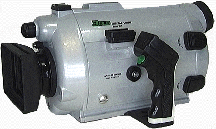 Home : Video course : Module 2: Video Housings Home : Video course : Module 2: Video Housings
There are two primary functions of a camcorder
housing:
- to keep water off your precious equipment
- to make the camcorder inside easy to use.
With these points in mind certain industry trends
have emerged with regard to how housings are sealed and operated.
When it comes to ingress of water prevention is
always better than cure. Accessories such as leak
detectors (electronic devices with audible and sometimes visual LED
warnings that you install inside your housing) can help to give a sense of
security. However, the fundamental problem is keeping water out in the first
place and this is essentially a problem of design, with certain designs
proven to be more inherently successful at keeping water out than others.
The best designs should protect the user from his/her own mistakes - i.e. be
idiot proof (because of the sad fact that user error accounts for nearly all
floods).

The build quality of your housing should reflect
that there is a lot at stake inside! The most sensible material to build a
housing out of for use in the underwater environment is aluminium, either
cast or extruded.
It should be fully anodised and/or covered with acrylic enamel finish.
Plastics are also used extensively in housing manufacture but are not as
durable. Plastic housings also do not have the same heat sink properties as
aluminium and so are more prone to misting (condensation appearing inside
when taken from humid atmosphere into cold water).
Most housings are of the clamshell design, that is
to say they split at some point to allow access to the inside. The two
halves of a housing should open and close positively, not open accidentally,
and without the need of tools. With this brief in mind manufacturers almost
universally install stainless steel clasps these days rather than screws and
bolts. Clasp fasteners are pre-tensioned to give the correct closing
pressure and there can be no argument as to whether or not it is closed
properly. It is either open, or closed - end of story! For additional idiot
proofing most manufacturers employ the type of clasp with a safety
interlock, which cannot be opened accidentally.
Depth rating of housings is dependent upon many
variables, such as housing size and wall thickness, O-rings and structural
considerations. The depth rating for housings can vary between 60M (perspex
construction) and 100M (aluminium). Most housings should operate far beyond
sport diving limits (to give a margin for error) which, needless to say, is
also well below the depth where interesting subjects are found!
 It is almost
universally accepted that, in the fight against water ingress, having double
O-rings on all moving parts that go through the housing is a good idea.
Let's face it, one of the basic principles of diving is that you always have
a backup and double O-rings on all control lever shafts give added security
and longer periods between maintenance. You can't see them but it's nice to
know they are there! It is almost
universally accepted that, in the fight against water ingress, having double
O-rings on all moving parts that go through the housing is a good idea.
Let's face it, one of the basic principles of diving is that you always have
a backup and double O-rings on all control lever shafts give added security
and longer periods between maintenance. You can't see them but it's nice to
know they are there!
 The hidden
O-rings around control shafts can suffer abrasion, which will challenge
their integrity, if you allow salt crystals to form by drying out. It is
vital that you maintain your equipment by regular and prolonged (all night)
freshwater soaking (not a rinse under a tap) after each diving day - and do
not let it dry out after the dive before you get it to freshwater. More
about maintenance later... The hidden
O-rings around control shafts can suffer abrasion, which will challenge
their integrity, if you allow salt crystals to form by drying out. It is
vital that you maintain your equipment by regular and prolonged (all night)
freshwater soaking (not a rinse under a tap) after each diving day - and do
not let it dry out after the dive before you get it to freshwater. More
about maintenance later...
Next >> Video Housings
|